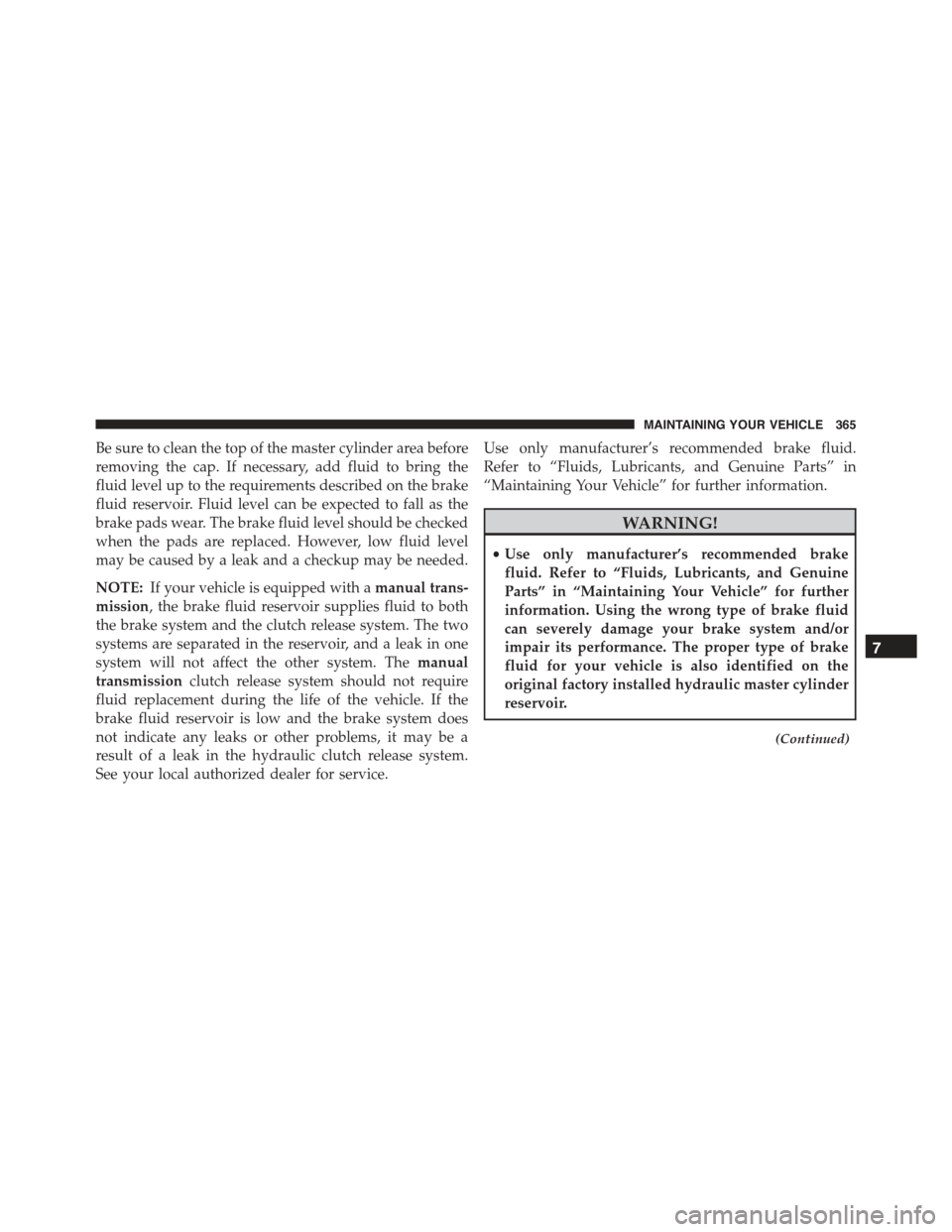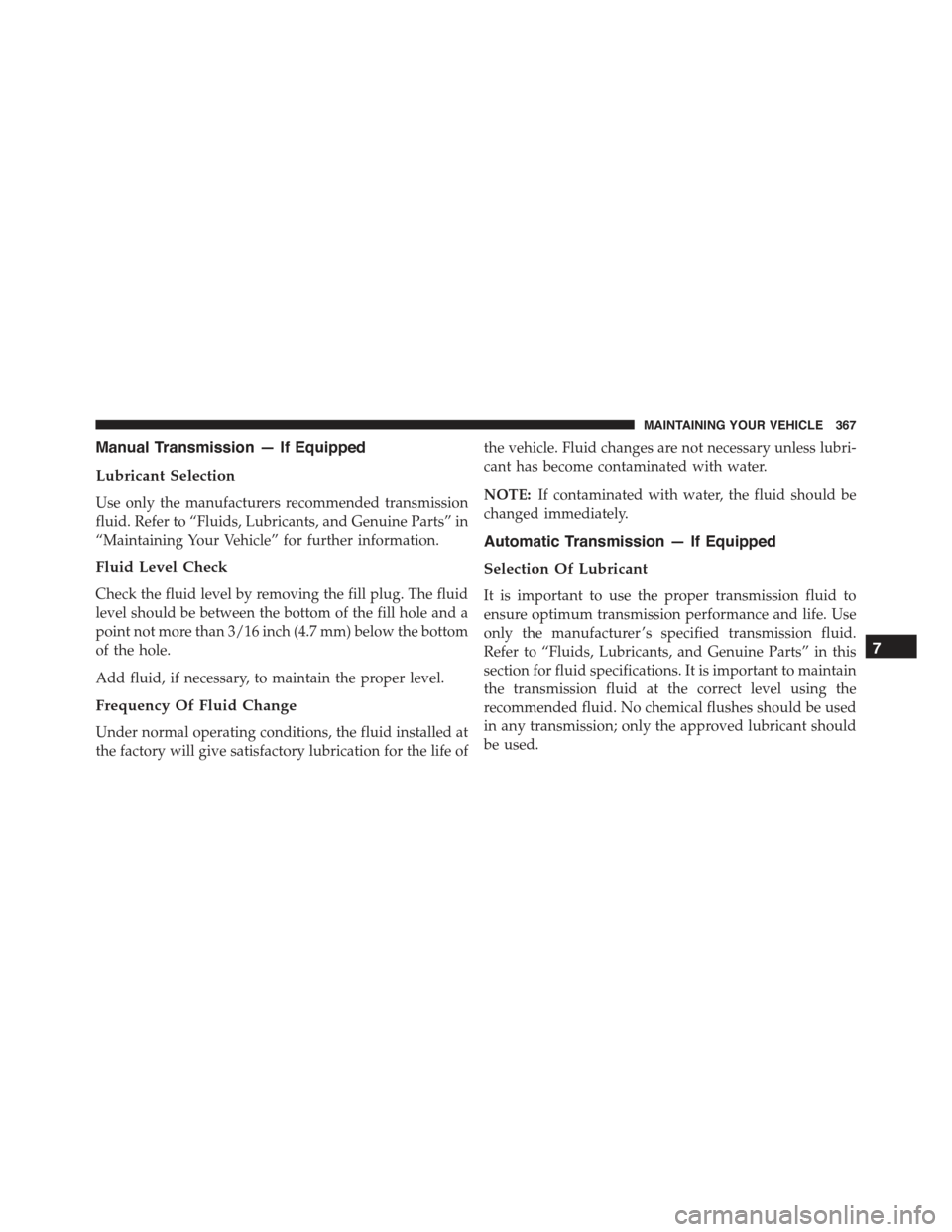2015 FIAT 500 ABARTH check transmission fluid
[x] Cancel search: check transmission fluidPage 316 of 426

4. Remove the cap from the valve stem and then screw
the fitting at the end of the Sealant Hose (6) onto the
valve stem.
5. Uncoil the Power Plug (8) and insert the plug into the
vehicle’s 12 Volt power outlet.
NOTE:Do not remove foreign objects (e.g., screws or
nails) from the tire.
(C) Injecting Tire Service Kit Sealant Into The
Deflated Tire:
•Always start the engine before turning ON the Tire
Service Kit.
NOTE:Manual transmission vehicles must have the
parking brake engaged and the shift lever in NEUTRAL.
•After pressing the Power Button (4), the sealant (white
fluid) will flow from the Sealant Bottle (1) through the
Sealant Hose (6) and into the tire.
NOTE:Sealant may leak out through the puncture in the
tire.
If the sealant (white fluid) does not flow within 0 –
10 seconds through the Sealant Hose (6):
1. Press the Power Button (4) to turn Off the Tire Service
Kit. Disconnect the Sealant Hose (6) from the valve
stem. Make sure the valve stem is free of debris.
Reconnect the Sealant Hose (6) to the valve stem.
Check that the Mode Select Knob (5) is in the Sealant
Mode position and not Air Mode. Press the Power
Button (4) to turn On the Tire Service Kit.
2. Connect the Power Plug (8) to a different 12 Volt
power outlet in your vehicle or another vehicle, if
available. Make sure the engine is running before
turning ON the Tire Service Kit.
3. The Sealant Bottle (1) may be empty due to previous
use. Call for assistance.
314 WHAT TO DO IN EMERGENCIES
Page 346 of 426

CAUTION!(Continued)
•Your vehicle has been built with improved fluids
that protect the performance and durability of your
vehicle and also allow extended maintenance inter-
vals. Do not use chemical flushes in these compo-
nents as the chemicals can damage your engine,
transmission, or air conditioning. Such damage is
not covered by the New Vehicle Limited Warranty.
If a flush is needed because of component malfunc-
tion, use only the specified fluid for the flushing
procedure.
Engine Oil
Checking Oil Level
To assure proper engine lubrication, the engine oil must
be maintained at the correct level. Check the oil level at
regular intervals, such as every fuel stop. The best time to
check the engine oil level is about five minutes after a
fully warmed engine is shut off. Do not check oil level
before starting the engine after it has sat overnight.
Checking engine oil level when the engine is cold will
give you an incorrect reading.
Checking the oil while the vehicle is on level ground, and
about five minutes after a fully warmed engine is shut
off, will improve the accuracy of the oil level readings.
Maintain the oil level between the range markings on the
dipstick. The safe range is indicated by a crosshatch zone.
344 MAINTAINING YOUR VEHICLE
Page 367 of 426

Be sure to clean the top of the master cylinder area before
removing the cap. If necessary, add fluid to bring the
fluid level up to the requirements described on the brake
fluid reservoir. Fluid level can be expected to fall as the
brake pads wear. The brake fluid level should be checked
when the pads are replaced. However, low fluid level
may be caused by a leak and a checkup may be needed.
NOTE:If your vehicle is equipped with amanual trans-
mission, the brake fluid reservoir supplies fluid to both
the brake system and the clutch release system. The two
systems are separated in the reservoir, and a leak in one
system will not affect the other system. Themanual
transmissionclutch release system should not require
fluid replacement during the life of the vehicle. If the
brake fluid reservoir is low and the brake system does
not indicate any leaks or other problems, it may be a
result of a leak in the hydraulic clutch release system.
See your local authorized dealer for service.
Use only manufacturer’s recommended brake fluid.
Refer to “Fluids, Lubricants, and Genuine Parts” in
“Maintaining Your Vehicle” for further information.
WARNING!
•Use only manufacturer’s recommended brake
fluid. Refer to “Fluids, Lubricants, and Genuine
Parts” in “Maintaining Your Vehicle” for further
information. Using the wrong type of brake fluid
can severely damage your brake system and/or
impair its performance. The proper type of brake
fluid for your vehicle is also identified on the
original factory installed hydraulic master cylinder
reservoir.
(Continued)
7
MAINTAINING YOUR VEHICLE 365
Page 369 of 426

Manual Transmission — If Equipped
Lubricant Selection
Use only the manufacturers recommended transmission
fluid. Refer to “Fluids, Lubricants, and Genuine Parts” in
“Maintaining Your Vehicle” for further information.
Fluid Level Check
Check the fluid level by removing the fill plug. The fluid
level should be between the bottom of the fill hole and a
point not more than 3/16 inch (4.7 mm) below the bottom
of the hole.
Add fluid, if necessary, to maintain the proper level.
Frequency Of Fluid Change
Under normal operating conditions, the fluid installed at
the factory will give satisfactory lubrication for the life of
the vehicle. Fluid changes are not necessary unless lubri-
cant has become contaminated with water.
NOTE:If contaminated with water, the fluid should be
changed immediately.
Automatic Transmission — If Equipped
Selection Of Lubricant
It is important to use the proper transmission fluid to
ensure optimum transmission performance and life. Use
only the manufacturer ’s specified transmission fluid.
Refer to “Fluids, Lubricants, and Genuine Parts” in this
section for fluid specifications. It is important to maintain
the transmission fluid at the correct level using the
recommended fluid. No chemical flushes should be used
in any transmission; only the approved lubricant should
be used.
7
MAINTAINING YOUR VEHICLE 367
Page 370 of 426

CAUTION!
Using a transmission fluid other than the manufac-
turer ’s recommended fluid may cause deterioration
in transmission shift quality and/or torque converter
shudder. Refer to “Fluids, Lubricants, and Genuine
Parts” in this section for fluid specifications.
Special Additives
The manufacturer strongly recommends against using
any special additives in the transmission.
Automatic Transmission Fluid (ATF) is an engineered
product and its performance may be impaired by supple-
mental additives. Therefore, do not add any fluid addi-
tives to the transmission. The only exception to this
policy is the use of special dyes for diagnosing fluid
leaks. Avoid using transmission sealers as they may
adversely affect seals.
CAUTION!
Do not use chemical flushes in your transmission as
the chemicals can damage your transmission compo-
nents. Such damage is not covered by the New
Vehicle Limited Warranty.
Fluid Level Check
The fluid level is preset at the factory and does not
require adjustment under normal operating conditions.
Routine fluid level checks are not required, therefore the
transmission has no dipstick. Your authorized dealer can
check your transmission fluid level using special service
tools. If you notice fluid leakage or transmission malfunc-
tion, visit your authorized dealer immediately to have
the transmission fluid level checked. Operating the ve-
hicle with an improper fluid level can cause severe
transmission damage.
368 MAINTAINING YOUR VEHICLE
Page 411 of 426

Automatic Transmission....................233
Adding Fluid..........................368
Fluid and Filter Changes..................369
Fluid Change..........................369
Fluid Level Check.......................368
Fluid Type............................390
Gear Ranges...........................237
Special Additives.......................368
Autostick...............................242
Battery.................................347
Jump Starting..........................327
Keyless Transmitter Replacement (RKE)........18
Belts, Seat...............................79
Body Mechanism Lubrication.................353
B-Pillar Location..........................267
Brake Assist System.......................254
Brake Fluid.............................388
Brake, Parking...........................248
Brakes.................................364
Brake System............................252
Anti-Lock (ABS)........................252
Master Cylinder........................364
Parking..............................248
Warning Light.........................148
Brake/Transmission Interlock.................235
Bulb Replacement.........................382
Bulbs, Light..............................81
Capacities, Antifreeze (Engine Coolant)..........387
Capacities, Fluid..........................387
Caps, Filler
Fuel.................................300
Oil (Engine)...........................345
Carbon Monoxide Warning...................78
Cargo Area Features.......................137
Car Washes.............................370
CD (Compact Disc) Player...................182
10
INDEX 409
Page 414 of 426

Emergency, In Case of
Hazard Warning Flasher..................307
Jacking...............................320
Jump Starting..........................327
Towing..............................334
Emission Control System Maintenance..........340
Engine
Air Cleaner...........................346
Break-In Recommendations.................76
Checking Oil Level......................344
Compartment..........................339
Cooling..............................358
Exhaust Gas Caution.....................78
Fails to Start...........................229
Flooded, Starting.......................229
Fuel Requirements......................295
Oil . . . . . . . . . . . . . . . . . . . . . . . . . . . . . . . . ..344
Oil Filler Cap..........................345
Oil Selection...........................345
Overheating...........................307
Starting..............................227
Enhanced Accident Response Feature............50
Euro Twin Clutch Transmission
Fluid Type............................367
Event Data Recorder........................55
Exhaust Gas Caution........................78
Exhaust System...........................78
Exterior Lights............................81
Filters
Air Cleaner...........................346
Air Conditioning.......................350
Engine Oil............................346
Engine Oil Disposal.....................346
Flashers
Turn Signal............................81
Flash-To-Pass............................110
Flooded Engine Starting....................229
412 INDEX
Page 415 of 426

Fluid, Brake.............................390
Fluid Capacities..........................387
Fluid Leaks..............................81
Fluid Level Checks
Automatic Transmission..................368
Fluids.................................388
Fluids, Lubricants and Genuine Parts...........388
Fog Lights..............................113
Freeing A Stuck Vehicle.....................331
Fuel...................................295
Adding..............................300
Additives.............................298
Capacity.............................387
Clean Air.............................296
Filler Cap (Gas Cap).....................300
Gasoline..............................295
Light................................148
Materials Added........................298
Octane Rating..........................295
Requirements..........................295
Specifications..........................388
Tank Capacity..........................387
Fueling................................300
Fuses..................................376
Gas Cap (Fuel Filler Cap)...................300
Gasoline, Clean Air........................296
Gasoline (Fuel)...........................295
Gasoline, Reformulated.....................296
Gauges
Odometer.............................148
Gear Ranges.............................237
Gear Select Lever Override..................333
General Information.......................295
General Maintenance.......................343
Glass Cleaning...........................374
10
INDEX 413